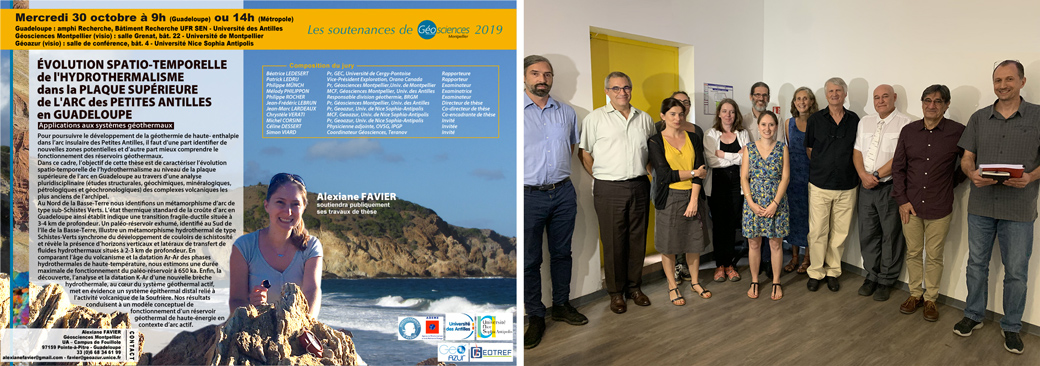The ninth GEOTREF PhD has been defended by Alexiane Favier, the 30th October 2019, in the Université des Antilles, pôle Guadeloupe In Pointe-à-Pitre: Evolution of hydrothermal fluids in the upper crust of the Lesser Antilles island arc in Guadeloupe: applications to the geothermal systems.
Abstract
This thesis, as part of the GEOTREF project (a multidisciplinary innovative platform for exploration and development of high-enthalpy GEOThermal energy in Fractured REservoirs), aims to improve the thermo-mechanical evolution of high-energy geothermal reservoirs. The geothermal potential of Lesser Antilles arc is known since the 1980s in the geothermal field of Bouillante in Guadeloupe. In order to develop this resource, it is necessary to identify possible new key targets, and to better understand the modes of fluids and heat transfers in high-enthalpy geothermal reservoirs.
The objective of this work is thus to characterize the spatio-temporal evolution of hydrothermalism at the upper plate of the arc. For this purpose, we propose a multidisciplinary approach (combined structural, geochemical, mineralogical, petrological and geochronological analyses) focussed on the oldest volcanic complexes of the Guadeloupe archipelago. Being deeply eroded, these outcrops are key analogues of deep crustal parts of the volcanic arc.
The study of the Basal Complex located in the north of Basse-Terre Island reveals a hydrothermal metamorphism (arc metamorphism) developed under P-T conditions (sub-Greenschist facies) compatible with the conductive geothermal gradient measured today. This metamorphism, dated no more than 4 million years, establishes the standard thermal state of the crust of the island arc in Guadeloupe and shows that the brittle-ductile transition is located at depths of 3 to 4 km.
On the island of Terre-de-Haut (Les Saintes), an exhumed geothermal paleo-reservoir has been identified. Mineralogical and structural transformations have been characterized: they result from Greenschist facies a hydrothermal metamorphism (0.9 – 1.4 kbar, 360-375°C), synchronous with the development of pressure-solution controlled schistose corridors. The finite strain pattern of schistose corridors attests for both vertical and lateral hydrothermal fluid transfers at depths between 2 and 3 km. Comparison of the age of the volcanic activity and 40Ar-39Ar dating of the high-temperature hydrothermal phases at 2.59 ± 0.12 Ma allows us to estimate a maximum operating time of the paleo-reservoir at 650 ka.
Within the active geothermal system on Basse-Terre Island, the discovery, the analysis and the K-Ar dating of a new hydrothermal breccia at Vieux-Habitants reveals a link between current geothermal activity and volcanic activity of the Grande-Découverte-Soufrière complex, interpreted in the framework of a distal epithermal system involving a progressive neutralization of fluids with respect to their distance to the heat source.
On the basis of all these data, a conceptual model for the operation of a high-energy geothermal reservoir in the context of an active arc is proposed which integrates different horizons of lateral, in particular the brittle/ducile transition, and vertical transfers of hydrothermal fluids.
Keywords: Low-grade metamorphism – Pressure-solution schistosity – High-temperature geothermal energy – 40Ar-39Ar and K-Ar dating – Lesser Antilles arc – Guadeloupe – GEOTREF.

